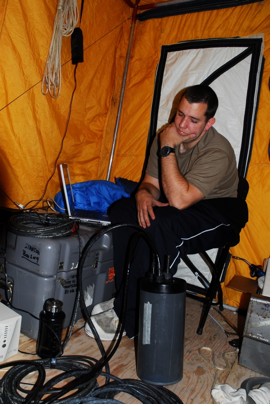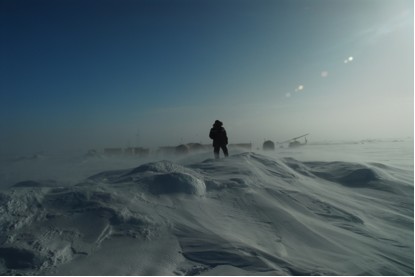2007 APLIS CampNPS masters students LT Tim McGeehan and LT John Bleidorn participated in the spring 2007 Applied Physics Lab Ice Station. The following is their account of the fieldwork We were probably the only NPS students this year who had to keep watch for polar bears while collecting data for our thesis projects. We had the unique opportunity to conduct research at the Applied Physics Lab Ice Station (APLIS) which was drifting on an ice floe in the Arctic Ocean about 200 miles north of Prudhoe Bay, Alaska. The ice camp was a two phase operation. The first phase was run by the Arctic Submarine Lab (a detachment of SUBDEVRON FIVE) and was primarily for submarine testing and training. After the Navy was finished, the camp was turned over to the National Science Foundation for scientific research. This represented the start of the US effort as part of the current International Polar Year, a worldwide scientific collaboration which takes place approximately every 50 years. We were there for the Navy part of the camp. We got to APLIS by flying in a Cessna from Deadhorse, Alaska. After a 2 hour flight the plane landed on a makeshift runway at the camp. There were usually 2 flights a day. The camp itself was composed of a number of prefabricated huts which housed about 40 people. The setup, logistics, and administration of the camp were done by the University of Washington's Applied Physics Lab. Our project was to measure under-ice turbulence near an ice keel as a component of Professor Tim Stanton's ocean turbulence research program. Ice keels form when ice floes collide and pieces break off. Some of the rubble gets pushed up forming a ridge and some gets forced down, forming a keel. Later, as the ice flow gets pushed by the wind, water is forced under these keels and there is a turbulent wake left behind it. This wake is important because it represents a loss of momentum and because if the keel is deep enough, warm water from below will get dragged up to the surface, where it will contact the underside of the sea ice. This can contribute to LTmelting the ice from below. Specifically, our project called for us to melt some holes through the ice so we could get to the ocean and deploy our instruments. We were hoping that the sea ice would be 6-8 ft thick, making the job of melting the holes fairly quick. Unfortunately, our floe turned out to be an average of 12-14 ft thick and the site where we actually did the experiment turned out to be much thicker, a spirit-breaking 41ft. In the end, we got our equipment deployed and collected our data. Working in the Arctic presented other challenges. You had to worry about the ice breaking, falling through spots of thin ice (that happened to someone the day we arrived), being eaten by polar bears, freezing to death, frostbite, getting lost, etc. It was also a constant struggle to keep our hole from freezing over. Every morning there would be 2 inches of ice on the surface that we had to break up and fish out. Fresh water for drinking and cooking came from melting some old ice, which meant everyone had to do their turn "mining ice" with the pick axe. You needed to bring tons of batteries since they die in minutes because of the cold. However, by far and away the worst part was using an unheated outhouse when the wind chill temperature was minus 67 F. All in all, the experience was great. Besides doing something productive for the Navy and for science, we had fun. We saw submarines surface through the ice during the day, the aurora and countless stars at night, and even a partial eclipse. The Arctic Submarine Lab is hoping to do another ice camp in 2009 and the commanding officer (an NPS alumnus) made it clear that he'd like an ongoing NPS participation in future camps. We highly recommend that anyone who has the chance to go seize it- it is a once in a lifetime opportunity.
|



